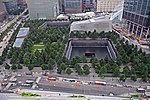Liberty Park
Aftermath of the September 11 attacksElevated parksParks in ManhattanUse mdy dates from May 2014West Side Highway ... and 1 more
World Trade Center

Liberty Park is a one-acre (4,000 m2) elevated public park at the World Trade Center in Manhattan, New York City, overlooking the National September 11 Memorial & Museum in Lower Manhattan. The park, which opened on June 29, 2016, is located above the World Trade Center's Vehicular Security Center. The St. Nicholas National Shrine is located within the park, as well as Fritz Koenig's The Sphere, the iconic sculpture salvaged from the World Trade Center site. Another statue, America's Response Monument, is also located in the park.
Excerpt from the Wikipedia article Liberty Park (License: CC BY-SA 3.0, Authors, Images).Liberty Park
Greenwich Street, New York Manhattan
Geographical coordinates (GPS) Address Website Nearby Places Show on map
Geographical coordinates (GPS)
| Latitude | Longitude |
|---|---|
| N 40.711067 ° | E -74.014278 ° |
Address
National September 11 Memorial & Museum (World Trade Center Memorial;9/11 Memorial)
Greenwich Street 180
10007 New York, Manhattan
New York, United States
Open on Google Maps









